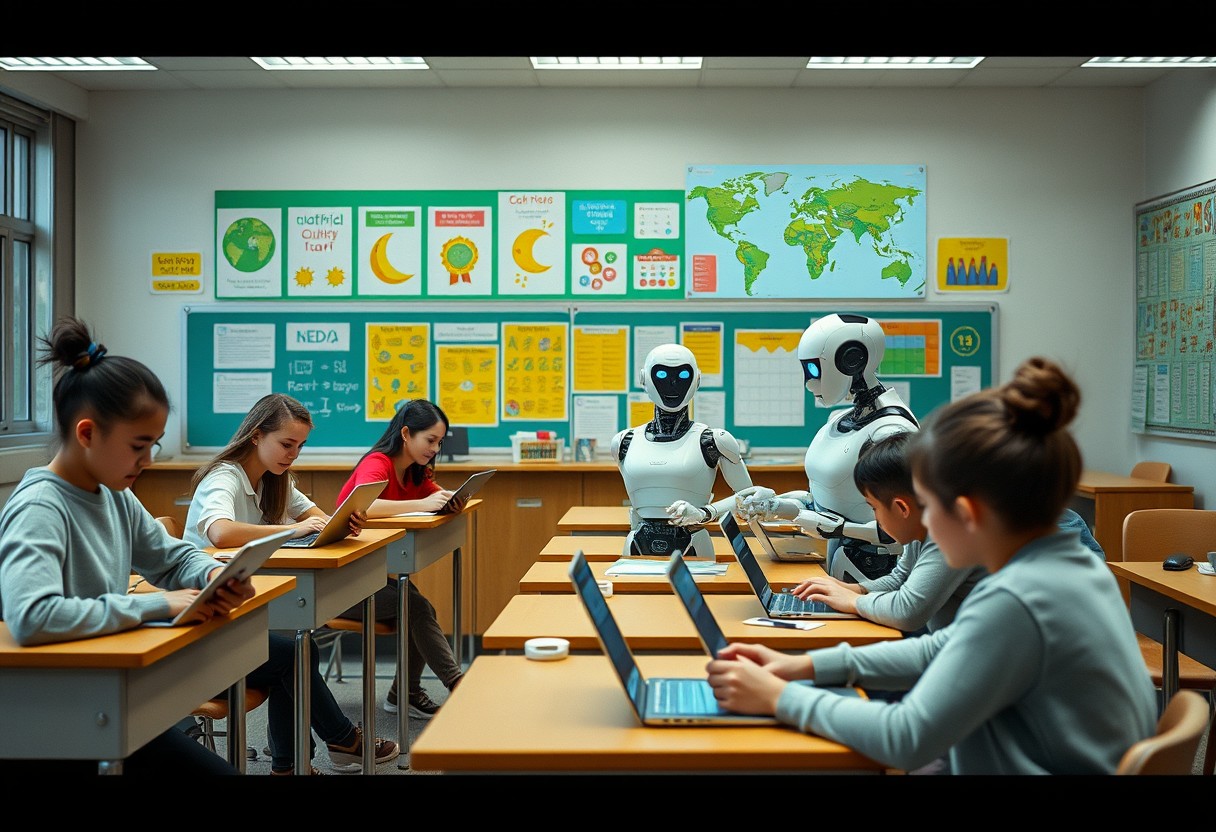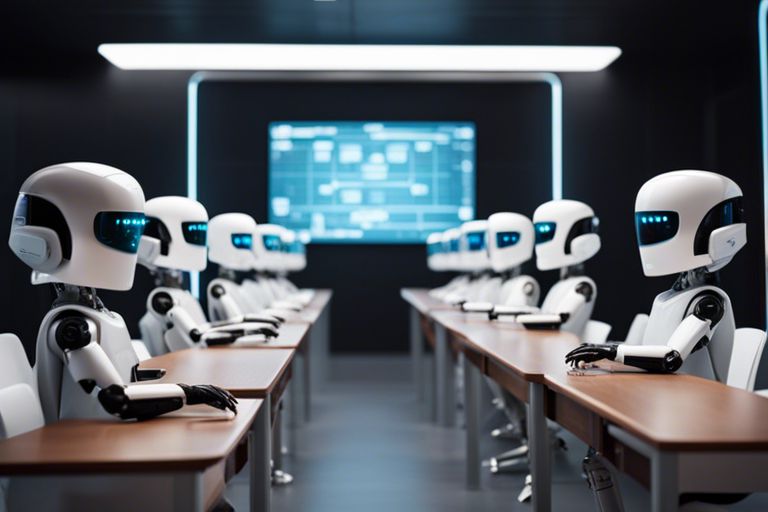Just imagine a world where students are not only equipped with theoretical knowledge but also gain hands-on experience from collaborating with industry leaders in the field of Artificial Intelligence (AI). These partnerships offer students a unique opportunity to learn about the latest technologies, trends, and real-world challenges, setting them up for success in the AI workforce. By bridging the gap between academia and industry, students can enhance their skills, network with professionals, and be better prepared for the demands of the rapidly evolving AI industry.
The AI Workforce Revolution
The Rise of AI in Various Industries
Revolution: In recent years, we have witnessed a profound shift in the workforce due to the rapid integration of artificial intelligence across various industries. From healthcare to finance, retail to transportation, AI technologies are transforming business operations, streamlining processes, and enhancing decision-making capabilities. This widespread adoption of AI signifies a shift towards data-driven, automated systems that can analyze vast amounts of information at speeds unimaginable to humans.
The Growing Demand for AI-Ready Professionals
One: As AI continues to reshape industries, the demand for AI-ready professionals is surging. Employers are seeking individuals with the skills and knowledge to develop, implement, and manage AI technologies effectively. From data scientists to machine learning engineers, the need for professionals who can harness the power of AI to drive innovation and growth is critical.
Workforce: This shift in the job market presents both challenges and opportunities for individuals looking to enter the AI workforce. By partnering with industry leaders, educational institutions can equip students with the necessary skills and expertise to thrive in an AI-driven world, bridging the gap between academia and industry demands.
The Role of Industry Leaders in Education
There’s a growing recognition of the invaluable role that industry leaders play in shaping the educational experiences of students, especially in fields like AI where the landscape is constantly evolving. By forging partnerships with these industry frontrunners, educational institutions can provide students with cutting-edge insights, practical knowledge, and hands-on training that are crucial for success in the AI workforce.
Collaborative Learning Initiatives
Learning through collaborative initiatives with industry leaders allows students to engage with real-world problem-solving scenarios, giving them a deeper understanding of how AI technologies are applied in various sectors. These partnerships often involve joint research projects, workshops, and guest lectures, offering students a unique opportunity to learn directly from experts who are driving innovation in the field.
Providing Real-World Experience and Mentorship
For students aspiring to enter the AI workforce, education alone may not suffice. By providing real-world experience and mentorship programs, industry leaders can offer invaluable insights into the practical applications of AI technologies and help students bridge the gap between theory and practice. These experiences not only enhance students’ skill sets but also give them a competitive edge in the job market.
Preparing Students for the AI Workforce
Even as technology continues to advance at a rapid pace, preparing students for the AI workforce remains a top priority for educational institutions and industry leaders. To ensure that students are equipped with the necessary skills and mindset to thrive in a technology-driven world, partnerships with industry leaders play a crucial role in shaping the future workforce.
Developing Essential Skills for AI Careers
Essential skills for AI careers go beyond technical knowledge and encompass a blend of critical thinking, problem-solving, and communication skills. By collaborating with industry leaders, educational institutions can tailor their curriculum to focus on hands-on projects, real-world applications, and interdisciplinary approaches to learning. This approach not only equips students with the technical expertise needed for AI roles but also hones their ability to adapt to evolving technologies and work effectively in team settings.
Fostering a Culture of Innovation and Creativity
An imperative aspect of preparing students for the AI workforce is fostering a culture of innovation and creativity within educational settings. By partnering with industry leaders known for their innovative practices, students can engage in experiential learning opportunities that encourage them to think outside the box, explore new ideas, and embrace failure as a learning opportunity. This fosters a mindset of continuous learning and adaptability, which are crucial for succeeding in AI careers where technologies and methodologies are constantly evolving.
Plus, by immersing students in an environment that values creativity and innovation, educational institutions can inspire them to push boundaries, challenge the status quo, and drive progress in the field of AI. This not only benefits the students individually but also contributes to the overall advancement of AI technologies and solutions in the industry.
The Benefits of Partnerships with Industry Leaders
Access to Cutting-Edge Technology and Resources
Despite the rapid advancements in artificial intelligence (AI), educational institutions often struggle to keep up with the latest technologies. By partnering with industry leaders, students gain access to cutting-edge technology and resources that may not be available within the confines of a traditional classroom. Through these partnerships, students can work with state-of-the-art AI tools and platforms, giving them hands-on experience with the same technology they will encounter in the workforce.
Staying Ahead of the Curve in AI Development
For educational institutions, the field of AI is constantly evolving, making it challenging to design curricula that reflect the most current trends and practices. Partnering with industry leaders allows schools to stay ahead of the curve by aligning their programs with the latest developments in AI. This ensures that students are equipped with the skills and knowledge that are in high demand by employers, giving them a competitive edge in the job market.
With rapid advancements in AI, it is crucial for students to be exposed to real-world applications and scenarios. Industry partnerships provide opportunities for students to engage in practical projects and gain insights into how AI technologies are being used in various industries. This hands-on experience not only enhances their learning but also prepares them for the challenges they will face in the workforce.
Building a Strong Foundation in AI Education
Your journey towards a successful career in the AI workforce begins with a solid foundation in AI education. By introducing fundamental AI concepts early on in educational programs, students can develop a deep understanding of the technology and its applications.
Introducing AI Concepts Early On
An imperative aspect of preparing students for the AI workforce is to introduce them to key concepts such as machine learning, neural networks, and natural language processing from the early stages of their education. Understanding these concepts not only equips students with the necessary knowledge but also allows them to explore the potential of AI in various industries.
Encouraging Interdisciplinary Approaches
Introducing students to AI concepts early on opens doors to interdisciplinary approaches that can enhance their learning experience. By combining AI with fields such as psychology, economics, or biology, students can develop innovative solutions to complex problems and gain a more holistic perspective on the applications of AI.
A multidisciplinary approach to AI education not only fosters creativity and critical thinking but also prepares students to collaborate effectively with professionals from different backgrounds in the AI workforce.
The Importance of Soft Skills in AI Careers
All industries, including AI, require a balance of technical skills and soft skills. In the rapidly evolving field of artificial intelligence, having strong soft skills is crucial for success. While technical skills are necessary for developing AI solutions, soft skills are equally important in helping professionals effectively communicate, collaborate, adapt, and innovate.
Effective Communication and Collaboration
Collaboration is key in AI careers, as projects often require interdisciplinary teams to work together to solve complex problems. Effective communication skills are necessary to convey ideas, discuss approaches, and provide updates on progress. Collaborating with colleagues from diverse backgrounds not only enhances the quality of AI solutions but also fosters creativity and innovation.
Adaptability and Continuous Learning
On the cutting edge of technology, AI professionals must possess the ability to adapt to rapidly changing trends and technologies. It is crucial for AI professionals to embrace continuous learning to stay ahead in this dynamic field. Adapting to new tools, techniques, and methodologies is necessary to remain competitive and drive innovation in AI solutions.
It is evident that soft skills play a vital role in preparing students for successful careers in the AI workforce. Developing effective communication, collaboration, adaptability, and continuous learning skills will not only enhance their technical abilities but also set them apart as versatile professionals ready to tackle the challenges of the AI industry.

Industry-Leader Partnerships in Action
Successful Collaborations and Their Impact
Impact: Keep building partnerships with industry leaders allows students to gain real-world experience and practical skills that are imperative for success in the AI workforce. Through collaborations, students can work on cutting-edge projects and learn from professionals who are leading innovation in the field. These experiences enhance students’ resumes and increase their employability upon graduation, giving them a competitive edge in the job market.
Overcoming Challenges and Obstacles
Collaborations: One of the main challenges in industry-leader partnerships is aligning academic and industry goals to ensure that both parties benefit from the collaboration. Communication and expectation management are crucial to overcoming potential misunderstandings and ensuring a mutually beneficial partnership. By establishing clear objectives and regular communication channels, these challenges can be addressed effectively.
To foster successful partnerships, institutions should also provide students with adequate support and resources to maximize their learning and development opportunities through these collaborations. By addressing challenges proactively and leveraging the strengths of both academia and industry, students can benefit immensely from these valuable partnerships.
The Future of Work in the AI Era
Job Displacement and Creation
Future job landscapes are expected to undergo a significant transformation due to the rise of artificial intelligence. Unlike previous industrial revolutions that primarily impacted manual labor, the AI era poses a unique challenge as it encroaches upon white-collar professional domains as well. While AI is poised to automate repetitive tasks and streamline operations, there is a growing concern about potential job displacement.
In this changing landscape, it is crucial to recognize that while some roles may become obsolete, new opportunities will emerge as well. Future jobs will likely require a different skill set, one that emphasizes adaptability, creativity, critical thinking, and emotional intelligence. By fostering a culture of continuous learning and upskilling, individuals can position themselves to thrive in a workforce that values human-centric skills alongside technological proficiency.
The Need for Human-AI Collaboration
Future AI systems are envisioned not as replacements for human workers, but as collaborators that complement human capabilities. Displacement fears can be mitigated through a strategic approach that leverages the strengths of both humans and AI. By understanding the unique advantages that each brings to the table, organizations can harness this synergistic partnership to drive innovation, enhance decision-making processes, and unlock new possibilities.
Developing AI Literacy Across Disciplines
Many educational institutions are recognizing the importance of integrating artificial intelligence (AI) literacy into various academic disciplines beyond computer science and engineering. By exposing students in non-technical fields to AI concepts and tools, they can better understand the implications and potential applications of AI in their respective fields.
Integrating AI into Non-Technical Fields
On the forefront of this movement are programs that embed AI education into areas such as healthcare, business, social sciences, and the humanities. For instance, students studying healthcare management may learn how AI can optimize patient care and streamline administrative tasks. Similarly, business students can explore how AI technologies can enhance decision-making processes and improve operational efficiency.
Fostering AI Awareness and Critical Thinking
For students enrolled in non-technical disciplines, fostering AI awareness and critical thinking is crucial in preparing them for a future where AI plays a significant role across industries. Developing an understanding of AI ethics, bias, and societal implications will empower students to navigate the ethical complexities that arise when integrating AI technologies into their fields of expertise.
Critical thinking skills are honed through discussions and projects that require students to evaluate AI applications critically, considering factors such as data privacy, algorithm transparency, and the potential impact on society. By fostering a multidisciplinary approach to AI education, students can develop the skills needed to address complex challenges and contribute meaningfully to the evolving AI workforce.
Addressing Diversity and Inclusion in AI Education
Breaking Down Barriers to Entry
Not everyone has had the same access to opportunities in Artificial Intelligence (AI) education. There are various barriers that can prevent individuals, especially those from underrepresented groups, from pursuing a career in AI. These barriers may include lack of exposure to AI concepts, limited access to resources and mentorship, and bias in the recruitment process.
Creating Opportunities for Underrepresented Groups
For far too long, underrepresented groups such as women and minorities have been marginalized in the field of AI. By creating tailored programs and initiatives that specifically target these groups, we can break down barriers and promote diversity in AI education. Providing scholarships, mentorship opportunities, and internships can help level the playing field and empower individuals who may not have had access to AI education otherwise.
This targeted approach not only enriches the diversity of perspectives within the AI workforce but also addresses the systemic inequalities that have long persisted in the industry. By actively working to include underrepresented groups, we can foster a more inclusive and innovative AI community that benefits from a wide range of voices and experiences.
The Role of Government and Policy in AI Education
Regulatory Frameworks and Guidelines
Government plays a crucial role in shaping the future of AI education by setting regulatory frameworks and guidelines. These measures help ensure that AI education is aligned with industry standards and best practices. By establishing clear guidelines, policymakers can protect students from unethical AI practices and ensure the quality of education in this rapidly evolving field.
Investing in AI Education and Research
Regulatory bodies need to prioritize investing in AI education and research to equip students with the necessary skills to thrive in the AI workforce. By allocating resources to AI programs and research initiatives, governments can promote innovation and create a pipeline of skilled AI professionals. Additionally, investing in AI education can drive economic growth and position countries as leaders in AI technology.
Understanding the importance of government involvement in AI education is crucial for preparing students for the AI workforce. Regulatory frameworks and investments in AI education not only protect the interests of students but also drive innovation and economic growth. By working closely with industry leaders, governments can shape the future of AI education and ensure that students are well-equipped to succeed in the AI workforce.
Measuring Success in AI Education Partnerships
Once again, partnerships with industry leaders in AI education must be measured to ensure they are effectively preparing students for the workforce. This can be achieved through defining key performance indicators and evaluating program effectiveness.
Defining Key Performance Indicators
Success in AI education partnerships can be determined by establishing key performance indicators (KPIs) that align with the goals of the program. These KPIs may include student retention rates, job placement post-graduation, employer satisfaction with graduates’ skills, and the number of students engaging in internships or co-op programs with industry partners.
Evaluating Program Effectiveness
Measuring the effectiveness of AI education partnerships involves assessing whether the program is meeting its objectives and producing the desired outcomes. This evaluation may involve analyzing student performance data, conducting surveys with industry partners, tracking graduates’ career trajectories, and gathering feedback from faculty and students.
Effectiveness in evaluating program effectiveness lies in the continuous improvement of the AI education partnership. By gathering and analyzing relevant data, making adjustments based on feedback, and staying attuned to industry trends, educational institutions can ensure their programs remain relevant and impactful in preparing students for the AI workforce.
Overcoming Challenges and Limitations
Now, while partnerships with industry leaders have numerous benefits, there are challenges that educational institutions may face in establishing and maintaining these collaborations. One significant hurdle is addressing funding and resource constraints.
Addressing Funding and Resource Constraints
Any educational institution looking to partner with industry leaders must consider the financial implications. Establishing programs or courses that align with the latest advancements in AI requires substantial funding for curriculum development, technology upgrades, and faculty training. Limited resources can hinder the ability of institutions to keep pace with industry demands and provide students with the necessary skills for the workforce.
Mitigating Bias and Ethical Concerns
Concerns surrounding bias and ethics in AI technologies are paramount. Any partnership between educational institutions and industry leaders must prioritize addressing these issues to ensure that students are prepared to navigate the ethical complexities of AI in the workforce. With AI systems increasingly influencing decision-making processes in various industries, it is crucial for students to understand the implications of biased algorithms and the ethical considerations involved in AI development and deployment.
With the rapid advancement of AI technologies, ensuring that educational programs incorporate discussions on bias, fairness, and ethics is crucial. As students prepare to enter the AI workforce, having a strong ethical foundation will not only enhance their professional capabilities but also contribute to the responsible and sustainable advancement of AI technologies.
Conclusion
As a reminder, partnerships with industry leaders are crucial in preparing students for the demands of the AI workforce. Through collaborations with companies at the forefront of technological advancements, students gain real-world experience, access to cutting-edge tools, and insights into the skills needed to thrive in the rapidly evolving field of artificial intelligence.
By engaging with industry leaders, students can bridge the gap between academic knowledge and practical application, ensuring they are well-equipped to meet the challenges of the AI workforce. These partnerships not only benefit students but also enrich the industry as a whole by fostering innovation, collaboration, and a pipeline of talent ready to drive advancements in artificial intelligence. Embracing these partnerships is key to shaping a future workforce that is poised to harness the full potential of AI technology.
FAQ
Q: Why is it important for students to be prepared for the AI workforce?
A: Being prepared for the AI workforce is crucial as artificial intelligence continues to shape various industries, and having the necessary skills will ensure students remain competitive in the job market.
Q: How can partnerships with industry leaders benefit students?
A: Partnerships with industry leaders provide students with real-world insights, access to cutting-edge technology, and networking opportunities that can help them gain a competitive edge in the AI workforce.
Q: What skills can students develop through partnerships with industry leaders?
A: Students can develop technical skills such as data analysis, machine learning, and programming, as well as soft skills like communication, collaboration, and problem-solving through partnerships with industry leaders.
Q: How do partnerships with industry leaders help students stay updated with the latest trends in AI?
A: Industry leaders are at the forefront of AI innovation, and partnerships with them provide students with opportunities to work on real-world projects, attend workshops, and conferences that keep them abreast of the latest trends in AI.
Q: Can partnerships with industry leaders lead to job opportunities for students in the AI field?
A: Yes, partnerships with industry leaders can lead to internships, job shadowing opportunities, and even full-time employment for students looking to kickstart their careers in the AI field.
Q: How do partnerships with industry leaders help in bridging the gap between academia and industry in the field of AI?
A: Partnerships with industry leaders facilitate collaboration between academia and industry, allowing for the exchange of knowledge, resources, and best practices that can help bridge the gap and ensure that students are equipped with skills that are relevant to the industry.
Q: What are some examples of successful partnerships between educational institutions and industry leaders in preparing students for the AI workforce?
A: Examples of successful partnerships include joint research projects, guest lectures by industry experts, mentorship programs, and collaborative initiatives that provide students with hands-on experience and insights into the practical applications of AI in different industries.




